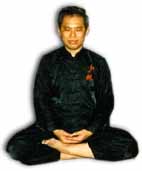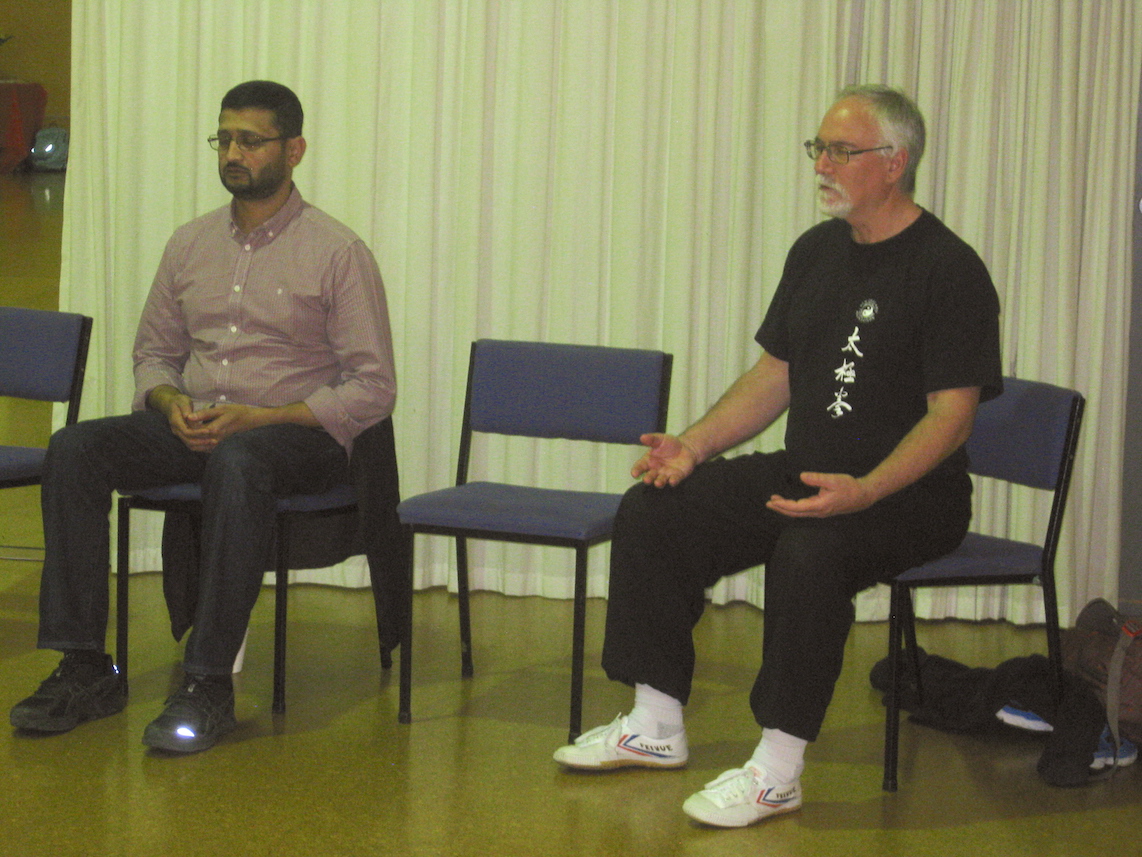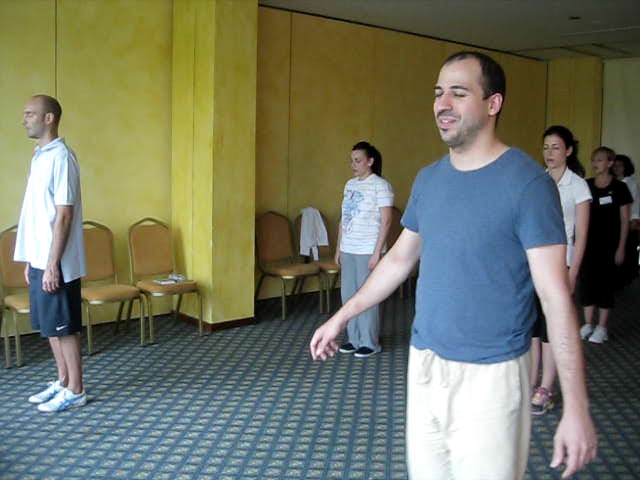DIFFERENT TYPES OF MEDITATION

Grandmaster Wong in sitting meditation
Meditation has been practised since ancient time by different peoples. Although their approaches and immediate objectives may be different, their primary aim is similar, that is the development of mind.
The approaches to meditation may be classified into two broad categories, namely active and passive. In active meditation, the meditator uses his developed mind for achieving a particular and immediate objective, like problem solving or acquiring ESP. In passive meditation, the meditator ignores immediate gains; he aims for long-term accomplishment, which is often spiritual enlightenment. Supernormal abilities occur to him as by-products.
The terms "active" and "passive" may be misleading to some English speaking readers unfamiliar with other languages or cultures. Active meditation is not necessarily more energetic nor demands more effort than passive meditation. In fact, passive meditation is generally more advanced and needs a longer time to achieve its set objectives. Perhaps a rough comparison is that active meditation is fast, while passive meditation is deep.
One-Pointedness and Emptiness
Throughout the ages different peoples have used a great variety of techniques for meditation. But all these techniques can be divided into two main groups, namely those that focus on one point, and those that focus on emptiness. Daniel Goleman, in his informative book "The Meditative Mind", reports a witty statement by Joseph Goldstein.
It's simple mathematics, he said: All meditation systems either aim at One or Zero -- union with God or emptiness. The path to the One is through concentration on Him, to the Zero is insight into the voidness of one's mind.
The Different Streams
In this chapter, we shall examine the major types or streams of meditation from the perspective of historical development. We shall discuss the Chinese, the Indian, the Tibetan, the Japanese and the Western types of meditation, as they not only exhibit different characteristics but also represent the major streams of contribution to the total development of meditation from different areas.
The criterion for classification here is geographical rather than philosophical; discussion based on philosophical classification, such as Buddhist meditation, Yogic Meditation and Christian meditation, will be discussed in the last chapter on the supreme achievement of meditation.
Here we shall discuss the general aims, philosophy and principal techniques of these major types, keepinin mind that there may be great variation or differ¬ences within each type. It is almost needless to say that the classification into Chinese, Indian etc. is for the sake of convenient study, certainly not because of any chauvinistic inclinations. Meditation of any types can be, and actually have been, practised and benefited by people of any race, culture or religion.
Chinese Types
Chinese types of meditation are much influenced by Buddhist and Taoist practice. The primary aim is spir¬itual development, the attainment of Buddhahood or immortality. Chinese meditation does not pay much emphasis on the acquisition of psychic powers or special supernormal abilities, though these powers and abilities inevitably result as bonus to the meditators.
The Buddhists believe that everyone has the Buddha nature in him; and the Taoists believe that everyone has an immortal soul. Meditation is the essential, if not the only, way to release the Buddha or the soul from the temporary physical body. Chinese meditation, therefore, is geared to the liberation of the mind or soul.
In Chinese meditation techniques the focus is on Zero rather than on One. Generally, the emphasis is on meditating the void, rather than making the mind one-pointed. This is a distinct difference in approach from Indian types of meditation. The principles of wu-wei and wu-hsin, which are central in Taoist and in Buddhist philosophy respectively, are very important in Chinese meditation.
Literally translated as non-action, wu-wei refers to the spontaneous avoidance of activities that contradict the Way of Nature. Wu-hsin, literally meaning no-mind, refers to the meditative state where the individual mind dissolves itself into the Universal Mind.
The following description is the gist of the meditation method taught by Wu Chung Shui to attain sainthood. The whole process takes about ten years. Wu Chang Shui was a famous Taoist saint living in the Ming period.
Sit quietly in deep meditation and focus on the void. Let chi (cosmic energy) flow round the "small universe" (a continuous flow of energy round the body along the two most important front and back meridians). Build a pearl of chi at the Field of Elixir (vital area of energy focus) at the abdomen. Strengthen and enlarge the chi, and let it permeate the whole body. Gradually direct the pearl of chi to the Heavenly Gate at the crown of the head. Open the crown aperture and let the immortal soul emerge.
Indian Types
Indian meditation is much influenced by yoga practice. The aim of yoga is to achieve union with God. God or Brahman is the Ultimate Reality which underlies this apparent, ephemeral universe. God is everywhere; it is present within every sentient being as well as inanimate object. Meditation is the way to be united with God, so that the divine aspect of man is merged with the universal Reality.
The great Vedas of the Indians teach that the whole universe is a projection of God or Brahman, and that God dwells within the heart of everyone of us, and is known as Atman or the true Self. Meditation liberates the true Self so that it unites with Brahman.
The Upanishads, which are those aspects of the Vedas that deal with the knowledge of God, says
The secret of immortality is to be found in purification of the heart, in meditation, in realization of the identity of the Self within and Brahmnan without. For immortality is union with God.
Patanjali, the Father of Yoga, described the processes leading to the union with God as dharana, dhyana and samadhi, which may be translated as concentration, meditation and enlightenment. Concentration is holding the mind within the centre of spiritual consciousness in the body, or fixing it on some divine form, either within the body or outside it. Meditation is an uninterrupted flow of thought toward the object of concentration.
As a result, the true nature of the object shines forth, undisturbed by the mind of the meditator. This is samadhi, or enlightenment. When these three -- concentration, meditation and enlightenment -- are brought about, it is called samyama, the disappearance of all distinction and differentiation with the realization of the Universal Consciousness.
Indian meditations emphasize on achieving a one-pointed mind, which is a notable contrast with the Chinese emphasis on emptiness. Nevertheless, both the Indians and the Chinese practise passive meditation; theirs is a long-term process of mind development with the ultimate aim of spiritual fulfillment, not the short-term techniques of acquiring special powers.

Meditation sitting on a chair during a Zen course
Tibetan Types
Tibetan meditation is mainly founded on Theraveda Buddhism and Tibetan Lamaism. Nevertheless, the Tibet¬ans also lay much emphasis on the Bodhisattva ideal, the essence of which is to help others.
The primary purpose of meditation is to achieve clarity of mind to serve as the basis for religious fulfillment. They believe in rebirths, whereby the mind is transmitted from one life to another. The main aim is to cultivate the mind so that it will have a good path in successive lifetimes, or in this lifetime it can break away from the cyclic existence.
Tibetan techniques are usually shrouded in secrecy. The following meditation technique, however, is clearly explained, in condensed form here, by His Holiness the Dalai Lama himself:
Sit in either the full or half cross-legged posture... The backbone is to be straight¬ened like an arrow; the neck is to be bent just a little downward; aim the eyes over the nose to the front; attach the tongue to the roof of the mouth; leave your lips and teeth as usual; and leave your arms a little loose, not forcing them against the body.
If your mind is involved with desire or hatred, it is necessary first to engage in a technique to loosen from it. Meditation on the inhalation and the exhalation of the breath up to a count of twenty-one is the prime means for doing so ... Then, it is necessary to form a virtuous motivation of compassion and altruism, wishing to help others ...
Do not let your mind think about what has happened in the past, nor let it chase after things that might happen in the future; rather, leave the mind vivid, without any constructions, just as it is... If, rather than the mind, you use an external object of observation ... visualize it mentally, causing an internal image of it to appear in the mind.
Tibetan meditation is also well known for its development of psychic powers. Lobsang Rampa in many of his books, like "The Third Eye" and "The Cave of the Ancients", suggests that supernormal abilities like telepathy, clairvoyance and astral travel are quite common among the Tibetans.
It is also reported that some Tibetan meditators seal off their doors and windows, thereby absolutely cutting themselves off from the outside world. Hence, either they must succeed in their meditation training and be liberated in their astral bodies or other means, or they perish in their self-imprisoned cells. The use of sounds and mystical designs is also quite common in their meditation techniques.
(D) Japanese Types
Probably the most typical and best known of Japanese meditation is Zen meditation. "Zen" is the Japanese word derived from the Chinese "Chan", which in turn is derived from the Sanskrit "Dhyana", meaning meditation.
Zen Buddhism was developed by the Indian monk Bodhidharma at the Shaolin Temple in the 6th century in China, and later spread to and became popular in Japan. It is no surprise, therefore, that Zen meditation is widely used in advanced Shaolin Kungfu and advanced Karate.
The aim of Zen meditation is to achieve a state of no-mind, which is actually mind in its purest, univer¬sal form, without any distortions and disillusions. A remarkable feature of Zen is its great emphasis on doing, and its utmost disregard for theoretical knowledge. The aspirant sits in the full or half lotus posture in zazen (sitting meditation), and let his mind be void.
If thoughts appear in his mind, he is to throw the thoughts away; or, if he fails to do so, just note the thoughts or mental images without any conscious thinking on them. In this way, satori is achieved, that is, a clarity of mind that sees things as they really are.
A Zen master applies this satori in all his daily living, not just when he is in meditation. A student once asked a master what Zen was. He replied, "When I eat, I eat; when I sleep, I sleep. That is Zen." In other words, the Zen master is always mindful of what he is doing now.
A unique method, besides zazen, to help a student to achieve satori is the use of koans. A koan is a question that is non-sensible to the ordinary thinking mind, such as "What is your primordial face?" Using knowledge or intellect to solve the question is futile, because there is no logical answer to such an "illogical" question.
The student meditates on the non-sensible koan until it drives him to a feverish pitch, as he cannot find any intelligent answer to the question. Then, in a flash of insight, he realizes that ordinary conscious thinking cannot give him the answer: he achieves satori. He discards his ordinary thinking mind, and achieves no-mind.
In Western psychological terms, he by-passes his ordinary conscious level to reach his deeper sub-consciousness. The answer he had been trying very hard to find may now suddenly appear to him apparelled in celestial lights. He does not merely think of the answer; he knows by direct inner experience.
Western Types
It is a common mistake to think that meditation is the prerogative of the East. In fact, the West has practised meditation since ancient times, and has achieved a very high level. Meditation was the essential means of training for prophecy-making in the ancient Greek world, such as at the famous oracle at Delphi and at Dodona. Christian saints practised meditation, and used it to perform miracles. Goleman says that
The meditation practices and rules for living of these earliest Christian monks bear strong similarity to those of their Hindu and Buddhist renunciate brethren several kingdoms to the east.
In modern times meditation, in the forms of deep relaxation and going into the alpha level, is a necessary condition used by western parapsychologists for developing ESP. D. Scott Rogo, in his impressive book "Our Psychic Potentials", stresses that
Learning to be psychic does not entail sending the mind "out" someplace and bringing information back to the brain and body. ESP is not a process like radar in which we must be alert for any significant incoming signals. It is a process of going deep within the self and retrieving information that is already there.
The aim of Western types of meditation is to train the mind to reach higher levels of consciousness, so as to communicate with gods and goddesses as in the case of the ancient oracles; or to develop psychic powers as in modern parapsychology.
The ancients taught, as at the famous Temple of Wisdom at Eleusis, that "every human being has two bodies, the other physical garment which may be seen and touched and another more subtle body which inter¬-penetrates and fits into the outer body, corresponding exactly with all of its parts." This astral body is the animating principle of the physical body. Medita¬tion is the way to reach this astral body and use its esoteric abilities.
The following is the gist of a technique taught to Solon at the mystery school at Eleusis.
Sit or recline in a comfortable position. Concentrate on the small toe on the right foot. Then turn your attention to the toe next to it. Gradually spread your attention to the whole foot, then the shin, the knee, the thigh, and then the whole leg. In this way, successively turn your attention to the hip, buttock, sex organ, base of the spine, kidneys, stomach, liver, solar plexus, heart, lungs, throat, mouth, and ears.
Conclude with concentration on the forehead and finally on the eyes and the centre of the head. As attention is turned on various parts of the body, energy flows to those parts, and if the thought you hold is constructive, the energy is beneficial and stimulating to both the physical and the astral body.
This exercise, which the great Solon performed dutifully and consistently, was responsible eventually for developing in him fantastic abilities like telepathy, clairvoyance and the ability to read the Akashic records, that is, the ability to recall any action, any event that has taken place on this planet no matter how far back in the remote past!
Conclusion
Meditation has been the method used by peoples from different ages and cultures to train the most powerful thing in the world -- the human mind. Understandably, it must be done with the utmost care and reverence under the expert guidance of a master.
Trifling with it or abusing its powers will bring great harm to the practitioner. But pursued correctly and with the right intentions, the art of meditation will certainly bring you some of the most wonderful benefits you can ever imagine.

Our students derive a lot of benefits performing standing meditation
LINKS
